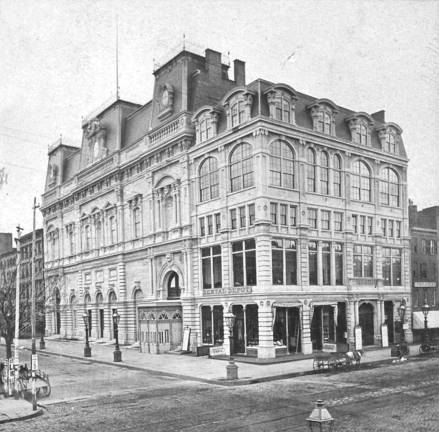when 23rd street was broadway Chelsea history

In the latter half of the 19th century, when you went to the theater, you may have gone to one of the houses on “Theater Row” on West 23rd Street.
West 23rd Street wasn’t only a theater district: a perusal of issues of The New York Times from those years shows that it also had restaurants, boarding houses, lecture halls, prestigious stores, fraternal organizations, the Art Students League and more.
East of Fifth Avenue on 23rd, you had the original YMCA building and the original home of City College (on the site of today’s Baruch College campus). To the west, you had the Pavonia Ferry to New Jersey. Holding it all together was the 23rd Street horsecar.
To be closer to the theaters, bonafide stars lived on 23rd Street. One of these was Lillie Langtry, who was as famous for her liaisons with European royals as for her theatrical roles. A Times report on a fire at her house at 361 W. 23rd St. revealed that it contained a tiger skin, a bearskin and portraits of the King of Denmark and the Prince and Princess of Wales.
The West 23rd Street Theater District included:
• Booth’s Theatre, built on the southeast corner of 23rd Street and 6th Avenue by Shakespearean actor Edwin Booth and opened in 1869. Booth was the brother of the notorious John Wilkes Booth, who assassinated Abraham Lincoln. Booth’s theater featured a lobby with Italian marble floors, a chandelier whose gas jets were lit by an electric spark system, marble pillars, and statues of Shakespeare and well-known actors of the day. Edwin Booth opened the theater with a production of “Romeo and Juliet.” For the next five years, he concentrated on the classics, but wasn’t able to make a go of it. In 1874, the theater was taken over by other impresarios. Despite theatrical and musical successes, including an appearance by Sarah Bernhardt, the building was sold in 1881 to a dry-goods store.
• Proctor’s Theatre was located at the current site of the Selis Manor residence for the blind, on the north side of 23rd Street between Seventh and Eighth avenues. The location was the site of several theatrical enterprises before it was bought by Frederick Francis Proctor and opened as Proctor’s in 1888. Proctor’s featured then-novel electric lighting and hosted an exhibition of another newfangled invention, the phonograph, in 1890. Proctor’s first concentrated on serious plays, but then switched to vaudeville. Among the famous acts who played here were the Three Keatons (featuring Buster Keaton), Will Rogers and Lillian Russell. By 1907, however, the theater converted to motion pictures. It eventually became part of the RKO movie theater chain, but fire decimated the building in 1937.
• Pike’s Opera House was opened in 1868 by entrepreneur Samuel Pike on the northwest corner of Eighth Avenue and 23rd Street. At first it presented grand opera. Some sources say its first performance was Il Trovatore, others say La Traviata (both by Verdi). But when robber barons Jay Gould and Jim Fisk took it over a year later and renamed it the Grand Opera House, they added operetta, debuting Offenbach’s La Pericohle, according to Daytonian in Manhattan. The website states that the Grand Opera House wasn’t able to turn a profit, and in 1876 added popular stage plays like “Uncle Tom’s Cabin.” In 1938, RKO took it over and remodeled it into a motion picture theater. RKO closed the theater in 1960 for demolition in preparation for the construction of Penn South. Today, the site is occupied by the small building, owned by Penn South, which houses Dallas BBQ, Dunkin’ Donuts, Baskin-Robbins, Pita Pan Café and the Mount Sinai Doctors medical facility.
Those weren’t the only theaters on the street. The 23rd Street entry for NYSonglines, a site tracing the history of Manhattan streets, address by address, mentions Koster and Bial’s Concert Hall, on the same corner of 23rd Street and 6th Avenue now occupied by Citibank. Koster and Bial operated from 1879 to 1924, and were described as a “popular vaudeville house featuring Victor Herbert’s orchestra.”
Leaving 23rd Street, at 312 8th Avenue nearby, you once had Miner’s 8th Avenue Theatre, part of a then-popular chain of variety theaters. The Cinematreasures website says that Miner’s burned in a fire in 1902 and was rebuilt as a theater that first showed both burlesque and films, but eventually showed movies only. It survived until about 1960. Now, you have a large new apartment building on the approximate site
Today on 23rd Street, you can find the Chelsea Bow Tie Cinemas between 7th and 8th; the School of Visual Arts’ multipurpose SVA Theatre between 8th and 9th, and the Cell Theatre, which bills itself as “a 21st century salon,” on the opposite side of the street between 8th and 9th. And if you go to Lillie’s, a Victorian-styled bar-restaurant at 13 E. 17th St., you’ll find a prominent likeness of Lillie Langtry, whose life the place celebrates.